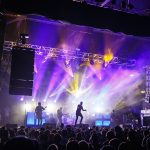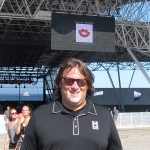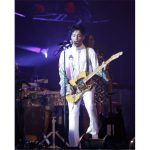A show director in the live events business is the person who oversees and orchestrates the mounting of a theatrical production. This person unifies all the different production elements and departments through their own vision to achieve the end result. This individual commands an army of specialists in their fields, working with the lighting and set designers, costumes, video directors, content creators, audio engineers, musicians and choreographers. To name just a few.
There was a time when only the big shows such as Broadway musicals and diva-driven pop concerts utilized the talents of these select individuals. But in the last ten years, I have seen a change in the business. From rock bands the like of Fall Out Boy to gospel choirs, all have hired show directors to help stage their performance.
Many LD’s unwittingly have become show directors, simply by talking to the artist and working dramatic moments into the show — like telling a sax player how cool it would be if he ran across the stage and dropped to his knee, sliding in with the opening note of a solo. The difference is that a show director doesn’t offer hints at what they might want to see at a certain point. He instructs everyone on everything. The director comes up with a game plan ahead of time, then reworks it into a fine-tuned spectacle by the time rehearsals are done.
Barry Lather is such an individual. His career evolved from being a dancer at a young age to mastering choreography in his 20’s. But that didn’t quench his artistic thirst. In his mind, he wanted artistic control over large productions and made it his goal to get there. The road there may have not been the smoothest, but the speed with which he has risen to be one of the top show directors in the biz has been swift. His shows are exciting works of dance, music and indeed, visual spectacles.

The Beginning
As a kid growing up in Atlanta, Barry didn’t have much choice but to get into dancing. His mom ran dance studios for as long as he could remember, while his dad had a store that sold dancewear. Being the youngest of five children, “my mother would drag me to these classes at the age of five. She’d put me in the back and instruct me not to move. But I was a kid with nothing to do. So, if I was going to be there anyway, I may as well dance.” he states. And so it began.
“I spent my youth watching Soul Train and Bandstand. This was the mid ‘70’s. I was fascinated watching people like Toni Basil with the Lockers, doing their routines on Soul Train. I just loved the robot dance moves as a kid.”
Lather spent time up north for a year and was able to see such Broadway shows as Bob Fosse’s Dancin,’ The Wiz and others that influenced him as well. That helped formally educate him in the art of choreography on a large stage. “I soon found myself fascinated by what was being called ‘street dancing’ back then. Later, they called it ‘break dancing.’ I used to emulate it, copy it and was inspired by it.”
MTV came out when he was young, and he became addicted to music videos as well. Soon, Lather started hanging at juvenile dance clubs and getting into dance circle competitions, where he perfected his own style of waves, robot moves and animation. At the same time, Barry had been educated in tap, jazz and ballet training. He combined those forms in with the street dancing moves he learned to form his own style. Some referred to it as “street jazz.” Soon after, hip-hop was born.

Headed to L.A.
Lather decided that if he was going to work as a dancer, he’d do better seeking employment in Los Angeles. He got a break when he was cast as a dancer in Captain EO, a 3D film of Michael Jackson’s, and on a couple of Janet Jackson videos that Paula Abdul choreographed. He moved on to do other gigs, but in the back of his mind he yearned to take it to the next level, to be a choreographer himself.
“I had always paid attention to how choreographers worked. I studied how they acted, communicated with others [and] came up with ideas, because I wanted to be prepared for when I got my big break.” Once again, he caught a break from Ms. Jackson, when she asked him to choreograph a video for her as opposed to just dancing in it.
“I was young and had aspirations, but I had a lot of work to do. I got some good advice from a friend back then,” Lather explains. “He said, ‘If you want to get serious about your craft, you must study the masters. Bob Fosse, Jerome Robbins and Michael Kidd, for instance.’ Well, I had heard of Fosse, but who were these other guys? I had some homework to do.
“Once I became a choreographer, I started paying attention to all the other aspects of production that I had never thought about,” Lather continues. “The lighting, the camera moves, what the director is doing, what he’s watching on the TV monitor. I started asking myself, ‘Should I change the choreography to make the other production elements stand out?’ These were questions I never asked myself before.
“I did a ton of music videos when I was getting started,” he continues. “Then, along the way I had a major epiphany. It dawned on me that I now wanted to be involved in the big production, as in ‘What’s the concept here? What are we going to do for a set? What’s the lighting going to look like on these costumes?’”
About this time, Lather got an idea, and he contacted his manager. He wanted to work for this young singer he noticed named Usher. He knew his new album was about to drop, the tour would be formulated, and this singer was the next Michael Jackson, in Barry’s eyes. His agent followed up, and somehow Barry got the gig.

Directing a Tour
“When I started, I had a bunch of ideas to show Usher, and I figured, as we went through them, we would pick out what would work and what wouldn’t. That was working well until one day — I was so young and I will never forget this — Usher asked me, ‘What are my lights gonna look like in the air?’ I had no idea. Steve Cohen was designing the set and lights, and it wasn’t done yet. I hadn’t anticipated the artist being this specific early in the development stage of the concepts. I was focused on the stage and the gags it can do, and not the lighting…yet.” Lesson learned.
The job of show director was new to Lather, and Usher already had a team of people in place. There already were a few choreographers, so that was no longer his gig. His job was to stage and help conceive the ideas for each song, then leave it up to the choreographer to come up with the actual moves. “For lighting, I offer suggestions of what I’d like to see. Such as, ‘Kill everything else and just give me a pool of white light down center so Usher can do his thing with the mic.’ I often suggest color palettes for songs to set the mood. I picture each song in my head. ‘Is it watery? Does it feel like fire?’ I may picture neon lights one song and lasers the next. ‘What is the mode of each song telling me?’”
To Barry, a show director is the person putting together all the visuals for a performance. “I will conceive an idea in my head, then pull a bunch of references together, such as pictures, structural imagery, lighting references, I pull a lot of photos I find online and then I put it all in writing to support my concepts and moods. This stems from early on in my career when a few artists told me, ‘I do better with pictures and references than I do understanding what someone is trying to explain to me in writing.’ Some artists interpret stuff differently. One artist may say they want to see ‘fire,’ and that means red. Others think it means shades of orange. In this day of cell phones, it’s easy for someone to pick out an image and say, ‘This is the actual color I’m looking for.’”
Last Year
Carrie Underwood went on tour last year with an over-the-top, in-the-round production and a stage set that spanned an entire arena floor. Barry was called on to design the show and direct it. The set had a center wedding cake-like stage that had lifts and separated into many levels, as did the video structure above it.
Barry had ideas, but he enlisted the help of production designer Butch Allen to bring his vision to fruition. “It was fantastic to work with Butch. I have ideas, but Butch has the knowhow in what I need, what is technically available to build this. He takes my ideas and adds to them. The collaboration between us was great, and he designed the lighting as well.”
When it comes to staging, the one thing Lather doesn’t care for is a flat stage. “I’m a person that wants multiple levels. Stairways, elevators [and] ramps are all tools I can use.” That played large in Underwood’s show. This set also had smaller stages at either end of the arena, connected to the main stage by ramps. But Lather needed one big thing in order to stage the performer and her musicians for each song. He required a set list. PLSN asked him how that usually comes together.
“Set lists are tricky. Very often, the artist will consult with their musical director and hand me their proposed list. I may view it and listen to it, making suggestions such as ‘You have three ballads in a row here, we need a tempo change.’ With Carrie, I got a list of songs that would be performed. Then I spent three weeks putting them in order and scripting the show in a treatment, before making a pitch. I explained every song’s detail and what the stage, color palettes, environment, and video rings looked like for most of the songs. Other times, I would suggest things like, ‘Right here, we have to ramp it up. I feel a transition coming up that involves a costume change, so we need to plan this out right to not lose any energy.’ The show’s theatrical flow and energy is so important to me — what the audience is feeling and what the pace is.”
In Closing
Barry takes notice of his audience. “When a production starts out, I will spend time moving around different parts of the venue gauging the people’s reactions to different parts of the performance. I want to know what their perspective is from where they are sitting. I can gauge the energy level or see if we are losing them at a certain point. From there, I can decide if a song is just weak, or if the visuals and dancing are lackluster and need some work. In the back of my head, I never stop thinking, ‘What can we do to make this better?’”


